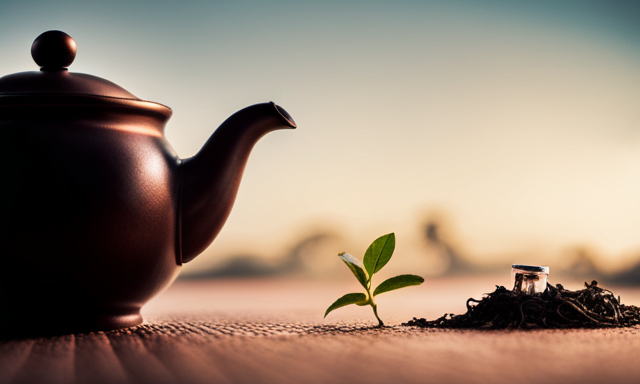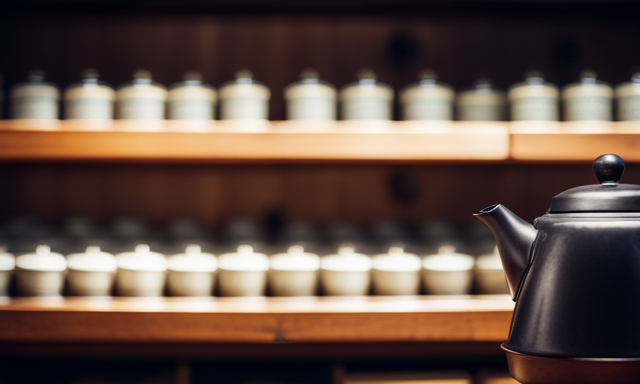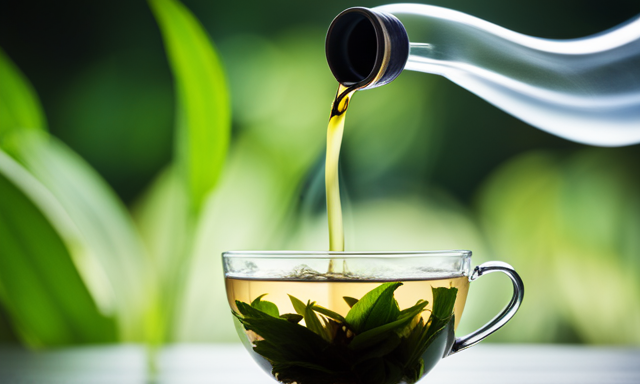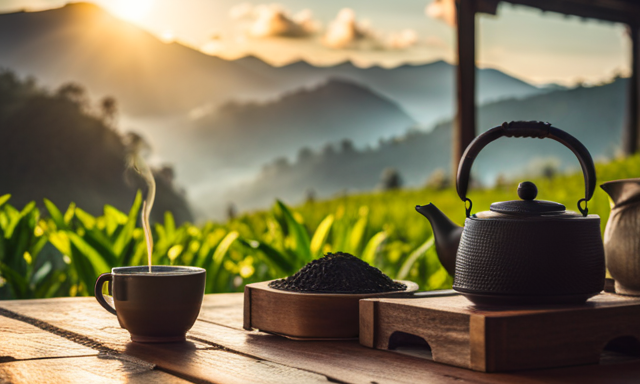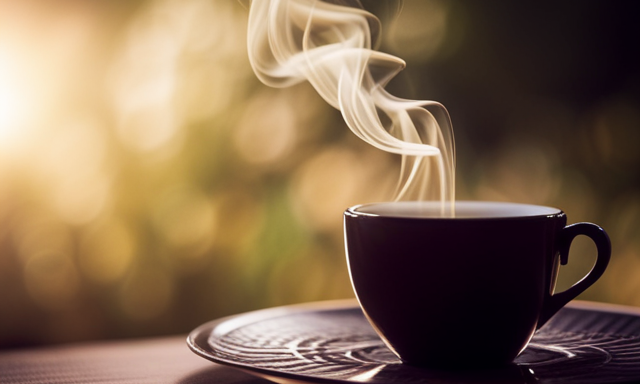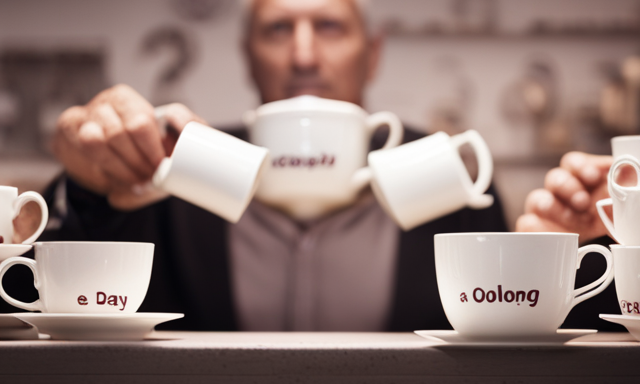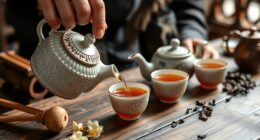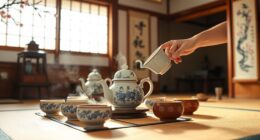As a tea enthusiast, I’ve always been fascinated by the world of different tea varieties and their unique characteristics. Oolong tea, in particular, has captured my attention with its rich flavor and enticing aroma. But one question that often comes to mind is, ‘How long does oolong tea last?’
It’s important to understand the shelf life of oolong tea to ensure that we can fully enjoy its freshness and goodness. In this article, we will delve into the factors that affect the longevity of oolong tea, explore the signs of spoiled tea, and discover ways to extend its shelf life.
Whether you’re an avid tea drinker or simply curious about oolong tea, this guide will provide you with the knowledge and tips you need to make the most out of this delightful beverage. So, let’s embark on this tea-filled journey and unlock the secrets of oolong tea’s longevity.
Key Takeaways
- Oolong tea can last for 1-2 years when stored properly in an airtight container away from sunlight, heat, and moisture.
- Drinking expired oolong tea is not a significant health risk, but the quality and taste may deteriorate over time.
- To determine if oolong tea is still good, check the appearance of the leaves and consider the storage conditions.
- To enjoy the freshness of oolong tea, store it in an airtight container and pay attention to brewing techniques. Consume it within a year for the best taste experience.
Introduction to Oolong Tea
Are you ready to discover the rich, aromatic world of oolong tea?
Oolong tea is a traditional Chinese tea that falls somewhere between green and black tea in terms of oxidation. This unique processing gives oolong tea its distinctive flavor and character.
Not only does it taste delicious, but oolong tea also offers numerous health benefits. It is known to boost metabolism, aid in digestion, and promote heart health. Oolong tea is rich in antioxidants and polyphenols, which help fight against free radicals and prevent cell damage.
Now that you understand the benefits and processing of oolong tea, let’s delve into understanding the shelf life of this exquisite beverage.
Understanding Shelf Life of Oolong Tea
Contrary to popular belief, oolong tea can maintain its flavor and freshness for a significant period of time. By understanding how to properly store oolong tea, you can extend its shelf life and continue to enjoy its delightful taste. Here are some essential storage tips to ensure the longevity of your oolong tea:
| Storage Tips | Description |
|---|---|
| Keep it airtight | Store oolong tea in an airtight container to prevent it from being exposed to air, which can cause oxidation. |
| Avoid moisture | Moisture can lead to the growth of mold and spoil the tea. Store it in a cool, dry place away from humidity. |
| Shield from light | Protect oolong tea from direct sunlight or artificial light, as it can degrade the quality and flavor over time. |
| Maintain temperature | Keep the tea away from extreme temperatures to preserve its aroma and taste. |
| Avoid strong odors | Oolong tea can easily absorb strong odors, so store it away from spices, perfumes, or other strong-smelling items. |
Understanding how to extend the shelf life of oolong tea is crucial in preserving its quality. Now, let’s delve into the signs of spoiled oolong tea without skipping a beat.
Signs of Spoiled Oolong Tea
Unfortunately, if you don’t store your oolong tea properly, it can quickly turn into a disappointing and undrinkable mess.
One of the key signs that your oolong tea has expired is a noticeable change in aroma. Fresh oolong tea has a pleasant, floral fragrance, but if it smells musty or stale, it has likely gone bad.
Another indicator is the appearance of the leaves. Expired oolong tea may have discolored or moldy leaves, which should be a clear warning sign.
Additionally, taste plays a crucial role in determining the quality of oolong tea. If your tea tastes flat or sour, it’s a sign that it’s no longer fresh.
To prevent this, proper oolong tea storage is essential.
Now, let’s explore ways to extend the shelf life of oolong tea.
Extending the Shelf Life of Oolong Tea
To extend the shelf life of oolong tea, follow these storage guidelines:
- Store your tea in an airtight container to prevent oxidation and flavor loss.
- Keep your tea away from direct sunlight or strong artificial light to avoid degradation of the leaves.
- Store your oolong tea in a cool and dry place, away from strong odors.
Following these storage practices will help maintain the freshness and flavor of your oolong tea for a longer period. Now, let’s move on to the best brewing practices for oolong tea.
Best Practices for Brewing Oolong Tea
For the ultimate oolong tea experience, immerse yourself in the art of brewing and savor the intricate flavors that emerge with each carefully steeped cup. To achieve the perfect brew, pay attention to the brewing temperature and steeping time. Here are three key factors to consider:
-
Brewing Temperature: Oolong tea is delicate and requires precise temperature control. Generally, the ideal brewing temperature ranges from 180°F to 205°F (82°C to 96°C). Steeping at higher temperatures can result in a bitter taste, while lower temperatures may not extract the full flavor.
-
Steeping Time: The steeping time varies depending on the specific oolong tea and personal preference. However, a general guideline is to steep oolong tea for 3-5 minutes. This duration allows the leaves to unfurl and release their flavors, creating a balanced and aromatic cup.
-
Experiment and Adjust: Don’t be afraid to experiment with different brewing temperatures and steeping times to find your perfect balance. Each oolong tea has its own unique characteristics, and adjusting these factors can enhance or highlight specific flavors.
Now, let’s dive into the fascinating world of different types of oolong tea.
Different Types of Oolong Tea
When it comes to oolong tea, there’s a world of variety and flavor to explore. Each type of oolong offers a unique taste experience. From the floral notes of Tie Guan Yin to the fruity undertones of Oriental Beauty, the range of flavors is vast.
Regional differences also play a significant role in the production of oolong tea. Different areas of cultivation result in distinct flavors and characteristics. So, exploring the different types of oolong tea is a great way to expand your tea palate.
Overall, oolong tea offers a wide range of flavors and characteristics to discover. Whether you prefer floral or fruity notes, there’s an oolong tea out there for you. So why not start exploring and find your new favorite?
Varieties and flavors
Did you know that oolong tea comes in a wide range of varieties and flavors, each offering a unique taste experience? Here are some of the different options you can explore:
-
Traditional oolong: This classic variety has a smooth, floral taste with hints of fruit and a slightly sweet aftertaste.
-
Milky oolong: Known for its creamy and buttery flavor, this tea is reminiscent of milk candy and is a delightful treat for your taste buds.
-
Tie Guan Yin: With its refreshing and floral aroma, this oolong tea is known for its light, delicate flavor and is often enjoyed during meditation or quiet moments of relaxation.
-
Da Hong Pao: This bold and robust oolong has a rich, roasted flavor with notes of honey and caramel, making it a perfect choice for those who prefer stronger teas.
Each of these varieties not only offers a unique taste experience but also provides various health benefits.
Now, let’s delve into the regional differences of oolong tea.
Regional differences
While exploring the world of oolong tea, you’ll discover a symphony of regional flavors that dance on your palate.
Oolong tea is cultivated in different regions, each with its own unique climate, soil, and altitude, which greatly affects the flavor profile of the tea.
For example, oolong tea from Taiwan is known for its floral and fruity notes, while oolong tea from China offers a wide range of flavors, from light and floral to dark and roasted.
Other regions, such as India and Sri Lanka, also produce oolong tea with their own distinct flavor profiles.
The regional cultivation of oolong tea contributes to its diverse and complex taste, making it a delight for tea enthusiasts to explore.
Moving on to popular oolong tea brands…
Popular Oolong Tea Brands
One cannot resist the exquisite flavors of popular oolong tea brands. These brands offer a wide range of options that cater to different taste preferences. Some of the most well-known and highly regarded oolong tea brands include Teavana, Tazo, and The Republic of Tea. These brands have gained popularity due to their commitment to producing high-quality oolong teas that deliver a rich and flavorful experience. Drinking oolong tea has various benefits, including boosting metabolism, promoting weight loss, and improving heart health. Incorporating oolong tea into your daily routine can be a delightful way to reap these advantages. As we explore other uses for oolong tea, you will discover its versatility beyond a simple beverage.
Other Uses for Oolong Tea
Now that we’ve discussed some popular Oolong tea brands, let’s explore the other uses and benefits of this versatile tea.
Oolong tea is not only a delicious beverage, but it can also be used for various purposes beyond just drinking. One of the common uses of Oolong tea is as a natural beauty treatment. Its antioxidants and anti-inflammatory properties can help promote healthy skin and reduce the signs of aging.
Additionally, Oolong tea can be used as a natural cleaning agent due to its antibacterial properties. It can be used to clean surfaces, remove stains, or even freshen up the air in your home.
With its numerous uses and health benefits, it’s no wonder why Oolong tea is gaining popularity.
Now, let’s move on to some frequently asked questions about Oolong tea.
Frequently Asked Questions about Oolong Tea
When it comes to oolong tea, one common concern is its expiration date. Many people wonder if oolong tea goes bad and if it’s safe to drink expired oolong tea. In this discussion, I will address these questions and provide insights on how to determine if your oolong tea is still good to consume.
Firstly, oolong tea does have an expiration date, just like any other food or beverage. However, the shelf life of oolong tea is generally longer compared to other types of tea. Properly stored, oolong tea can last for about 1-2 years. It is important to check the packaging for the expiration date and consume the tea before that date.
Secondly, even if your oolong tea has passed its expiration date, it doesn’t necessarily mean it is unsafe to drink. Oolong tea doesn’t spoil like perishable food items. Instead, it may lose its flavor, aroma, and some of its beneficial properties over time. However, if the tea has been stored properly in a cool, dry place away from sunlight and moisture, it may still be enjoyable to drink even after the expiration date.
To determine if your oolong tea is still good to consume, you can use your senses. Look for any signs of mold, discoloration, or unusual odor. If the tea appears or smells off, it is best to discard it. Additionally, if the taste of the tea has significantly changed or become unpleasant, it is a good indication that the tea has gone bad.
In conclusion, oolong tea does have an expiration date, but it can still be safe to drink even after that date. Proper storage and using your senses to assess its quality can help determine if the tea is still good to consume.
Does oolong tea expire?
Don’t worry, your oolong tea is like a fine wine, it only gets better with age, as long as you store it properly! Proper storage is key to extending the shelf life of oolong tea and maintaining its health benefits. To keep your oolong tea fresh, store it in an airtight container away from sunlight, moisture, and strong odors. This will prevent oxidation and maintain its flavor and aroma. Let me break it down for you in a simple table:
| Storage Tips | Benefits |
|---|---|
| Airtight container | Retains freshness and flavor |
| Away from sunlight | Prevents degradation of antioxidants |
| Away from moisture | Avoids mold and spoilage |
| Away from strong odors | Maintains original aroma and taste |
By following these storage guidelines, your oolong tea can last for up to two years. Now, let’s move on to the next section about whether you can drink expired oolong tea.
Can you drink expired oolong tea?
If you’ve come across a bottle of expired oolong tea, go ahead and give it a try – you might be pleasantly surprised by the unique flavors that have developed over time! Contrary to popular belief, drinking expired tea doesn’t necessarily pose significant health risks.
However, it’s important to note that the quality of the tea may have deteriorated, resulting in a less enjoyable taste experience. To preserve the tea’s quality, it’s best to store it in a cool, dry place away from direct sunlight and strong odors.
Now, let’s move on to how to tell if oolong tea is still good?
How to tell if oolong tea is still good?
Looking to savor a delightful cup of oolong tea? Wondering how to determine if it’s still at its peak of deliciousness? Well, fret not! There are a few shelf life indicators that can help you determine if your oolong tea is still good.
Firstly, pay attention to the appearance of the leaves. If they are dry, discolored, or have a strange odor, it’s a sign that the tea may have gone bad.
Secondly, consider the storage conditions. Oolong tea should be stored in an airtight container, away from light, heat, and moisture. Exposure to these elements can degrade the quality of the tea.
By keeping an eye on these indicators and storing your oolong tea properly, you can ensure that you always enjoy the freshness and deliciousness of this exquisite beverage.
Now, let’s move on to the conclusion: enjoying the freshness of oolong tea.
Conclusion: Enjoying the Freshness of Oolong Tea
Savor the delightful freshness of Oolong tea to truly indulge in its rich flavors.
To extend the shelf life of your Oolong tea and ensure its freshness, there are a few key factors to consider.
First, store your tea in an airtight container, away from heat, light, and moisture. This will help preserve its quality and prevent it from absorbing any unwanted odors.
Second, pay attention to the brewing techniques. Use water that is just below boiling temperature and steep the leaves for the recommended time to extract the best flavors.
Lastly, remember that Oolong tea is best enjoyed when it is fresh. So, try to consume it within a year of purchase to fully experience its exquisite taste.
Frequently Asked Questions
Can I consume oolong tea that has passed its expiration date?
Consuming oolong tea past its expiration date is generally safe, but the taste and quality may be compromised. Oolong tea benefits include promoting weight loss, reducing heart disease risk, and improving brain function. Oolong tea is made by withering, rolling, oxidation, and drying tea leaves.
How should I store oolong tea to ensure its freshness?
To preserve the freshness of oolong tea, store it in an airtight container away from light, moisture, and strong odors. This proper storage method ensures that the tea retains its flavor and aroma for an extended period.
Can I drink oolong tea if it has changed in color or aroma?
If your oolong tea has changed in color or aroma, it may be a sign of spoilage. However, there are ways to revive stale oolong tea and still enjoy it.
What are the potential health risks of consuming spoiled oolong tea?
Consuming spoiled oolong tea can pose potential health risks. It may lead to food poisoning, stomach upset, and even bacterial infections. It’s important to discard any tea that has changed in color or aroma to avoid these health issues.
Are there any natural remedies to revive the flavor of stale oolong tea?
Natural remedies like adding fresh herbs or fruits can help revive the flavor of stale oolong tea. By infusing the tea with these ingredients, you can enhance its taste and make it more enjoyable to drink.
Conclusion
In conclusion, Oolong tea is like a precious gem that must be cherished and enjoyed while it’s fresh. Its delicate flavors and aromas can be easily lost if not properly stored and consumed within a reasonable time frame.
By understanding the shelf life of Oolong tea and implementing best practices for brewing, we can ensure that every cup is a delightful experience.
So, let’s savor the richness of Oolong tea and make every sip a moment to treasure.

